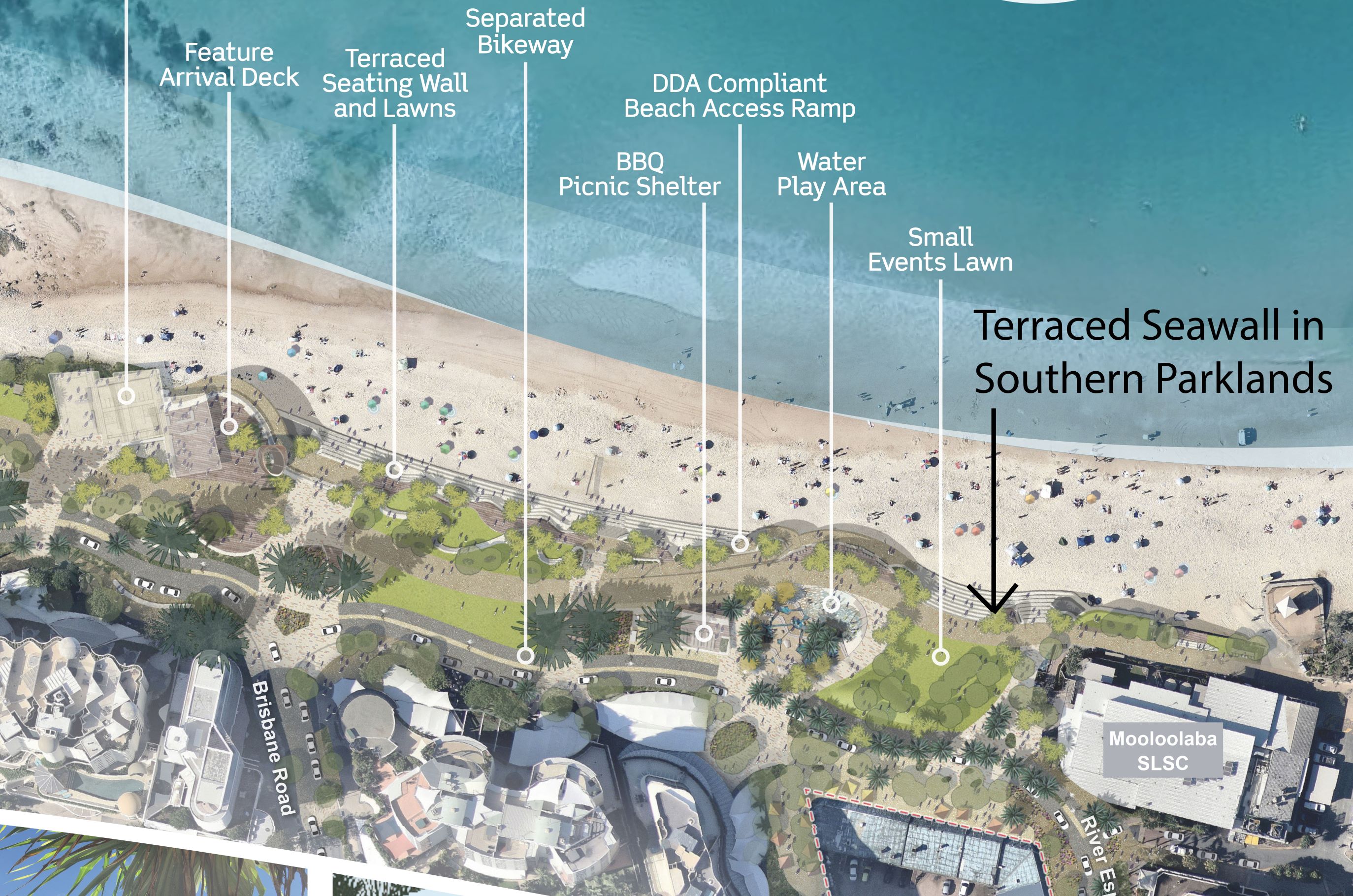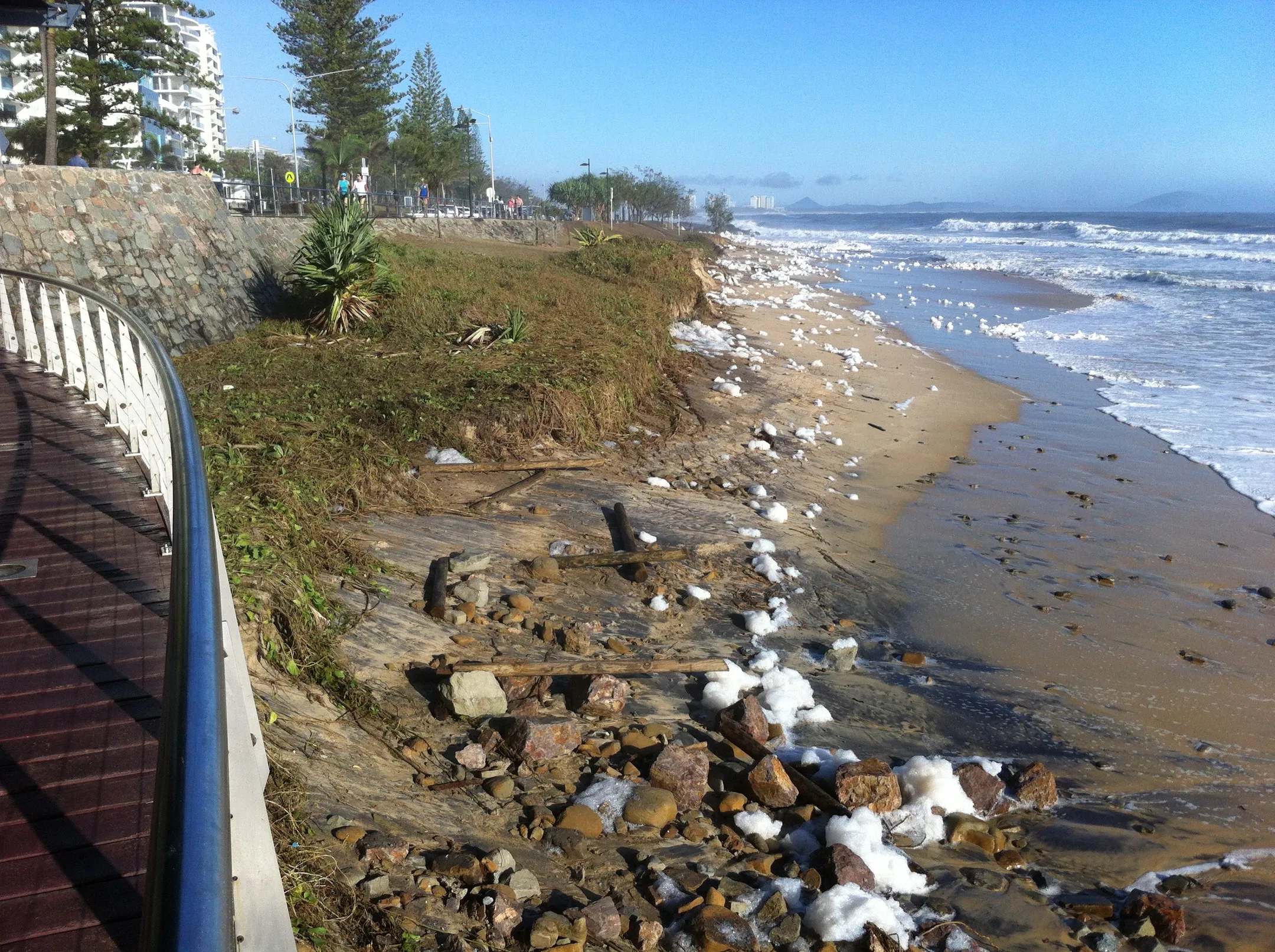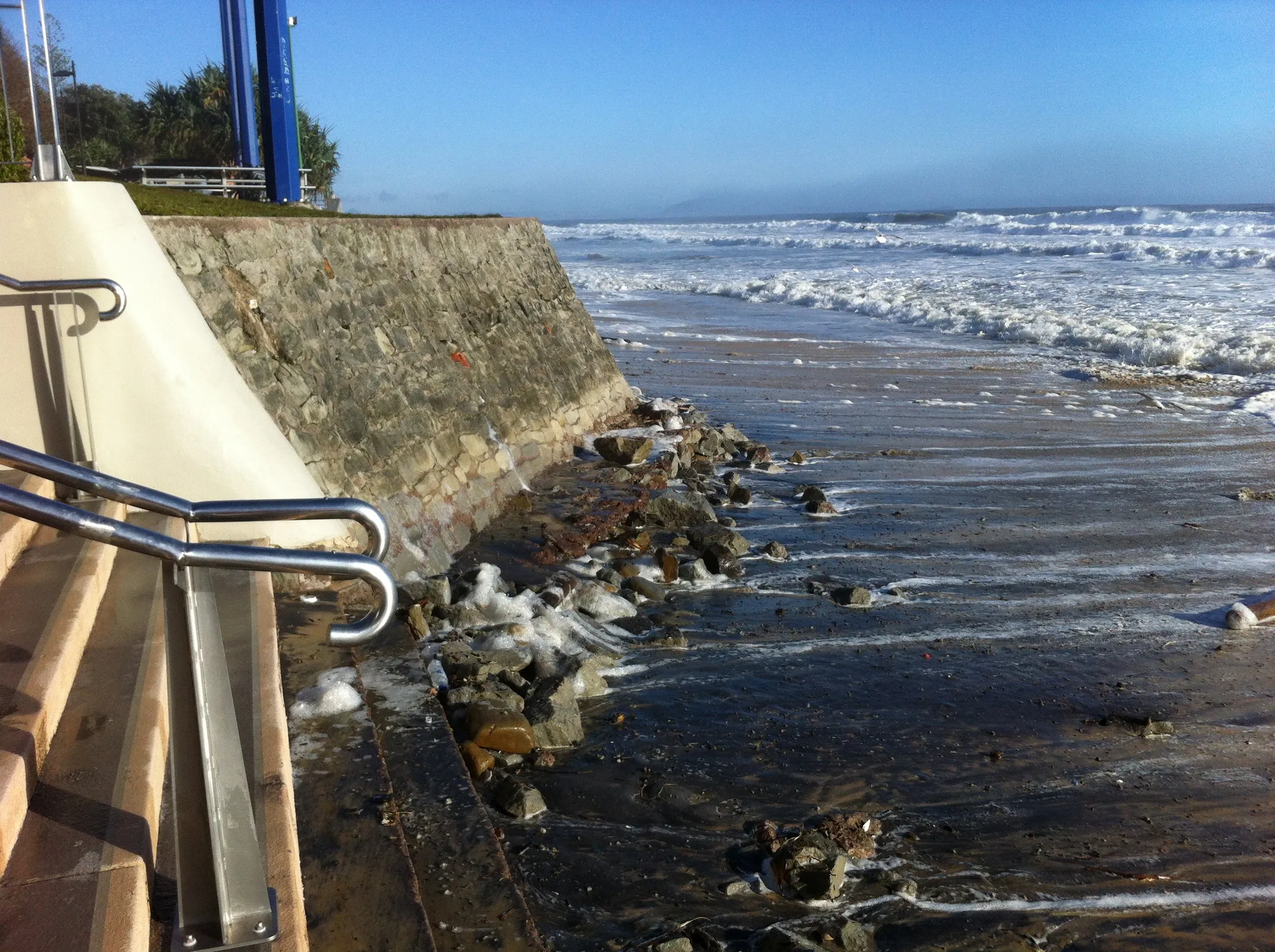Replacing the existing seawall
The replacement terraced seawall will increase coastal protection and enhance accessibility.

Why does the existing seawall need to be replaced?
A range of expert and independent assessments has confirmed that the existing seawall (built in the 1960’s) is not of a suitable height, design or condition to withstand future major storm events. Council’s 2021 Coastal Hazard Adaptation Strategy and Shoreline Erosion Management Plan indicate that areas of the foreshore, transport infrastructure and underground services are at significant risk of rising sea levels, natural disasters, coastal erosion, storm surges, coastal inundation and cyclones.
In 2013 the remnants of Ex-Tropical Cyclone Oswald caused significant damage to our region’s coastline due to the impacts of high rainfall, cyclonic winds, large waves and extreme sea levels. At Mooloolaba, significant coastal erosion was experienced impacting the existing vertical seawall, lifeguard tower and access to the Mooloolaba Surf Lifesaving Club.
Undermining of the seawall due to significant sand loss meant that emergency works were required to stabilise the site, reinstate the lifeguard tower and provide public and emergency services access back to the beach.
Some 10 years later it is predicted that extreme weather events will become more frequent in our region. Based on future climate change the existing seawall won't suitably protect the foreshore for the next 50-plus years, particularly if impacted by multiple extreme weather events.

Why does it need replacing now?
Replacing the seawall now will better protect the community parklands, paths, roads and underground services (such as power, telecommunications and water supply) from climate change impacts. As well as provide improved access from the foreshore to the beach, connects ‘beach to business’ by reducing physical and visual barriers and enhances access for our community with an all-abilities access ramp for people using wheelchairs, prams or mobility devices.
Combining the Central Meeting Place and Southern Parkland seawall construction as Stage Two has the potential to deliver cost and time efficiencies for our community as part of the foreshore’s overall revitalisation.
The seawall is the first critical step required to protect community infrastructure and allow the revitalisation of ageing community facilities and assets.
How does the design benefit this location and where does it sit?
Different environments require different seawall treatments. For Stage Two, the predominate use of a terraced seawall is considered the best design and outcome for the community in this location.
When compared to the existing vertical seawall the benefits are:
- enhanced beach access including an all-abilities access ramp for people using wheelchairs, prams or mobility devices
- multi-fuctional terraces with increased stair access and seating opportunities
- reduced potential fall hazard
- improved open views and visual amenity
- greater wave energy dissipation
- improved adaptability for future climate conditions
- connects ‘beach to business’ by reducing physical and visual barriers (i.e. handrails and barriers)
- wider 6m coastal pathway (previously 2-3m)
- more shade and increased grass picnic areas
- event space at arrival shelter and spectator experience.
Building another vertical seawall in the same location would mean a physical and visual barrier would exist between the beach and the foreshore, complete with a one-metre-high fence and railings. Unlike a terraced seawall it would not allow for seating areas or landscaping opportunities (including shade trees and plants for greening the foreshore) or fulfill the accessibility expectations of our community or Council. Some vertical elements will be required to allow ramp access to the beach and a viewing deck to enjoy the beach and ocean views.
The terraced steps/seats will be the perfect place to watch the waves or attend major Mooloolaba events such as New Year’s Eve celebrations, festivals, the ANZAC Day service and beach sports like volleyball and rugby.
The seawall will be further enhanced by attractive landscaping, including plants and shade trees, along with revegetation of the adjacent dunal areas.
Where does it sit?
The following images show the existing and future seawall extents overlayed on both the existing aerial image and detailed design. The design strikes a balance between the amount of available park and beach space. The sinuous curved design of the seawall responds to the natural ‘wave’ environment and originates from Kabi Kabi name for Mooloolaba ‘mulu’ meaning snapper fish, or 'mullu' meaning red-bellied black snake.
Of the total Mooloolaba Beach (Alexandra Headland to The Spit), the Stage Two project reduces the useable beach space by 171sqm (less than half a basketball court). An additional 864sqm (equivalent to two full basketball courts) of seating terraces and landscaped areas will be delivered as part of Stage Two via the terraced seawall.
Download the images for a closer look.
How did Council develop the design?
The replacement of the seawall in this location has been identified in the 2021 Council’s Coastal Hazard Adaptation Strategy and Shoreline Erosion Management Plan.
It has been modelled and designed by a qualified coastal engineer and structural engineer as part of the project’s design team, both Registered Professional Engineers of Queensland.
The coastal engineering design has been peer reviewed by an Australian and International expert with a Master of Engineering Science degree, majoring in Coastal Engineering and Physical Oceanography with over 30 years of experience.
The replacement seawall has been approved by State Government approval agency SARA including referral departments.
As part of the seawall design process a range of information is considered including:
- Astronomical tides, extreme storm tide levels, and tidal planes
- Waves including historic wave data, wave buoy analysis, design wave data, wind-driven waves, and wave overtopping
- Sand levels and beach variability
- Beach and parkland usage
- Access to the beach, including all abilities access
These investigations, in addition to Council’s Coastal Hazard Adaptation Strategy have guided the design for Stage Two.
Why can’t the seawall be buried under parkland or closer to the buildings?
Seawalls provide erosion protection. They are designed to protect community infrastructure and services (parklands, paths, roads and underground services such as power, telecommunications and water supply) from the impacts of severe weather events and climate change.
If community infrastructure and services were located on the ocean side of the seawall they would be vulnerable to erosion during severe weather events. Based on current climate change predictions the community infrastructure and services are at extreme risk of being lost to the elements. This would cause significant economic, environmental and social impacts to Mooloolaba, particularly for businesses, residents and tourism.
The seawall is considered our ‘last line of defence’ and the alignment of the replacement seawall has been carefully considered to protect our community’s coastal infrastructure in this location. In other locations different seawall design treatments may be considered.
How is the replacement seawall being funded?
The replacement of the seawall is funded by Council's Capital Works Program and the Federal Government.
In June 2023, it was announced the project would receive $7.95 million in funding from the Federal Government’s National Emergency Management Agency Disaster Ready Fund toward replacing the seawall.
This significant financial contribution will minimise the cost to ratepayers while providing enhanced protection for Mooloolaba.
What is the history of community engagement for the foreshore revitalisation project?
2012-15 – Placemaking Mooloolaba Master Plan
The Master Plan which incorporates the Mooloolaba Foreshore Revitalisation project has been subject to extensive community engagement since its initial development. The Master Plan shows seawalls in all stages of the project – the Northern Parkland (now complete), Central Parkland, Central Meeting Place and Southern Parkland.
More than 3,000 participants took part in the community engagement exercise for the Master Plan. This established a clear understanding of core community values, as well as needs and aspirations and helped to generate the vision, principles and strategies of the plan. The Master Plan received a very high level of community support (82 per cent).
2019 –Detailed Design release
The 2019 Mooloolaba Foreshore Revitalisation project detailed design release, which evolved from the Master Plan, included full media coverage, a launch event, pop up sessions and a street walk where Council handed out project information. This project information release clearly showed the terraced seawall in the southern parklands.

2021 – Coastal Hazard Adaptation Strategy
Extensive community engagement was undertaken in the lead up to Council’s 2021 Coastal Hazard Adaptation Strategy. That strategy, together with the Shoreline Erosion Management Plan, signified that areas of Mooloolaba’s foreshore public land, transport infrastructure, and underground services are at significant risk of rising sea levels, cyclones, coastal erosion, storm surges and coastal inundation.
2022 – Central Meeting Place
Extensive community engagement was carried out between April and October 2022 to determine a preferred concept for the Central Meeting Place. 75 per cent of the public supported a new design that included a terraced seawall, which was approved by Council in January 2023 at its Ordinary Meeting.

The community stated a clear preference for improved inclusion and accessibility. The new seawall will incorporate a new easy-access ramp to the beach for everyone that is disability compliant, the first of its kind on the Sunshine Coast.
Stage Two has been extended from the Central Meeting Place to the Mooloolaba Surf Lifesaving Club to include the Southern Parkland seawall section. Replacing this section of seawall as part of the Stage Two works will deliver significant cost and time efficiencies as part of the foreshore’s overall revitalisation.
Design continuity will also provide optimal amenity and enhanced protection for Mooloolaba.
Learn about the extensive community engagement on our Have your say site.






